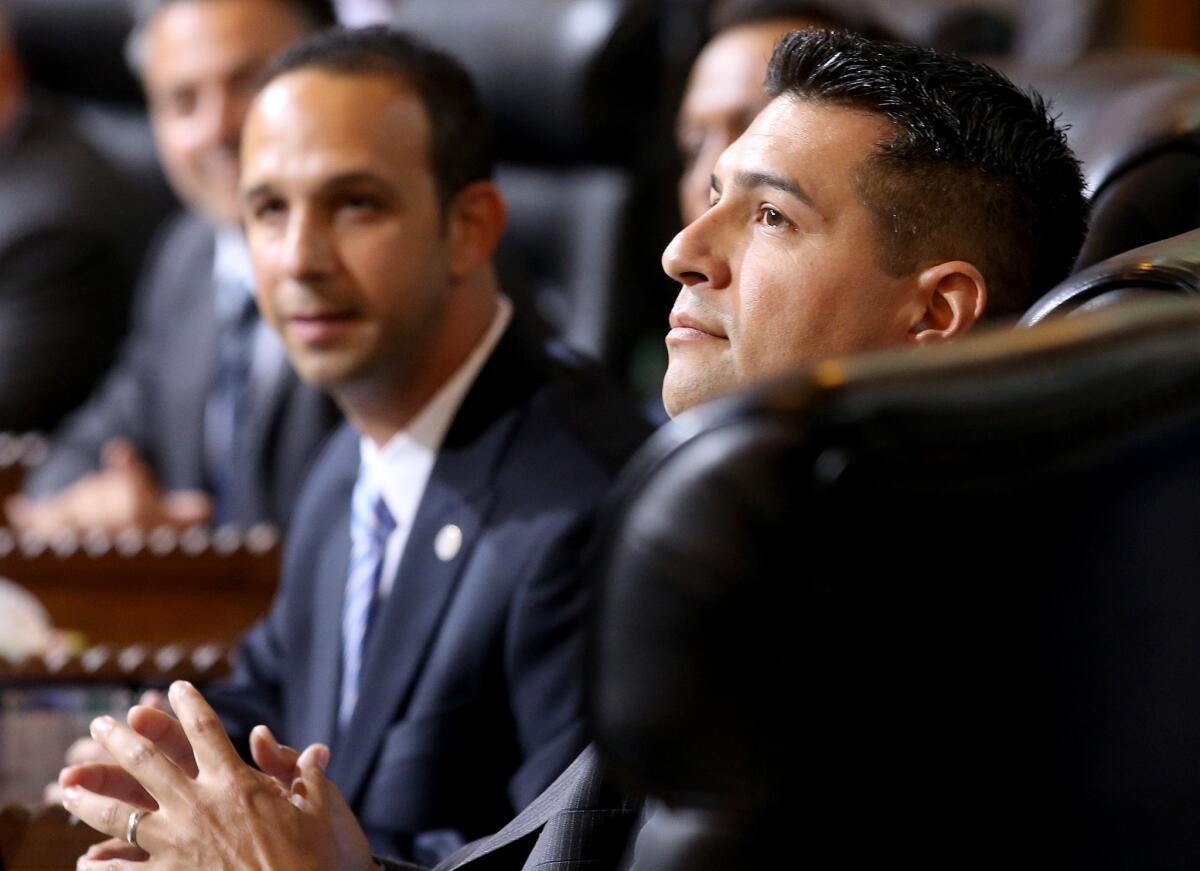L.A. councilman wants to put ground-based solar arrays on pause

- Share via
Worried solar farms could overtake prized patches of open space, a Los Angeles councilman is asking the Department of Water and Power board to put off allowing new arrays that are mounted on the ground -- part of its Feed-In Tariff program -- until the city can make sure they mesh with neighborhoods.
Councilman Felipe Fuentes argued that before any more such projects are approved, the city should work out a “city planning review process” that would allow community reaction. In a letter to the board, he asked for officials to take action before the utility’s next round of solar applications this summer.
Fuentes’ council district includes Lake View Terrace, where residents have raised concerns about proposed installations.
His request is the latest turn in a burgeoning debate over how tightly the city can regulate one of its solar programs. As Los Angeles tries to bulk up on solar, it finds two of its green goals on an unexpected collision course -- the quest for renewable power and the desire to preserve open space.
Los Angeles has become the largest municipality in the country to operate a Feed-In Tariff program, which enables people to install solar cells and sell all the energy back to the city. As of early June, the city had entered into nearly 120 Feed-In Tariff agreements, pushing to install 150 megawatts through the program by the end of 2016.
But as solar power enjoys an upswing, critics complain that communities have too little ability to stop vast arrays that clash with the feel of their neighborhoods, and fret that open space is at risk.
“It’s not about being against solar power; I’m all for it,” said Eddie Conna, who lives just outside of Los Angeles in Kagel Canyon and has raised concerns about proposed installations nearby. “But we shouldn’t be covering open space with solar panels when we have all these buildings and parking lots.”
City officials say under California’s Solar Rights Act, local jurisdictions are supposed to allow private solar installations unless they harm public health or safety. State law also bars the city from releasing the addresses of Feed-In Tariff requests until the Department of Water and Power signs a contract, according to the department.
As a result, Fuentes wrote in a letter last week to the Board of Water and Power Commissioners, “ground-mounted solar farms are moving forward with little to no community input.”
The issue recently erupted in Lake View Terrace, where one proposed project envisioned an array of 3,500 solar cells on an empty lot off Foothill Boulevard.
The Foothill Boulevard project got added scrutiny at a public hearing because it was along a scenic highway -- and was ultimately kicked back by a local planning commission. But city officials are still wrestling with how strictly they can regulate “commercial” arrays, senior city planner Robert Duenas said.
When Los Angeles and the state drafted its rules, “solar was something of a novelty,” Duenas said. “People put a couple panels in their backyard and thought they were being green.” Now “the industry has exceeded the regulations we have in place.”
“What if it’s just mom and pop with five panels?” Duenas asked. “Is that a business? I don’t know.”
Fuentes has suggested trying to amend the state law to give the city more control over such projects. Mel Levine, who authored the law as a state assemblyman and now heads the Water and Power board, said the state rules were written when solar was in its infancy and were meant to protect homeowners planting solar cells on their rooftops, not large arrays mounted on the ground.
Many new projects are taking that shape, however. Currently, 19 of the 119 sought-after or approved Feed-In Tariff projects in Los Angeles are mounted on the ground, according to the DWP.
“It’s cheaper and easier” to mount solar cells on the ground, said Bob Gibson, vice president of education and outreach for the Solar Electric Power Assn., a nonprofit based out of Washington, D.C. That can pose a conflict as solar expands. “As solar has come down in cost, it’s opened up more expensive land closer to populations. But they’re competing with other uses for that land.”
Fuentes argued that despite the restrictions of the state law, the city can tailor its own Feed-In Tariff program to favor rooftop installations. In his letter to the DWP board, Fuentes pointed out the city had already met state requirements to offer at least 75 megawatts through the program.
“Having met the state mandate, the board should have the discretion to modify the program requirements for future projects,” he wrote.
Follow @latimesemily for what’s happening at Los Angeles City Hall
More to Read
Sign up for Essential California
The most important California stories and recommendations in your inbox every morning.
You may occasionally receive promotional content from the Los Angeles Times.











